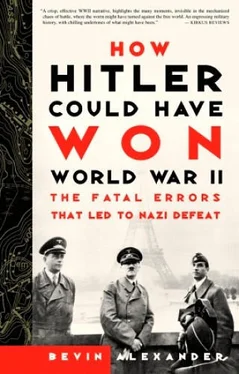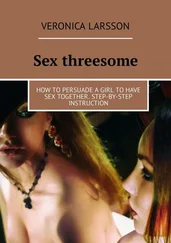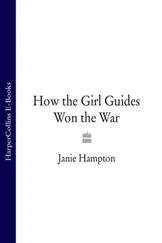The British seized Halfaya Pass, losing seven Matildas in the process. However, threats of German counterattacks on the flank caused the British to withdraw, leaving a small garrison at the pass. Rommel launched a sudden converging attack on May 27 and recaptured the pass. He dug in four high-velocity 88-millimeter antiaircraft guns, which had emerged as Germany’s best tank-killers. The guns, their barrels horizontal with little visible above ground, were to be of great importance in the next British effort, Operation Battleaxe.
Wavell planned Battleaxe as two separate operations. In the first, an infantry force, supported by half the British armor, a brigade of Matildas, was to seize Halfaya, Sollum, and Fort Capuzzo, eight miles to the west. In the second, the remaining armor was to cover the desert flank to the south to guard against the panzer regiment Rommel had posted there. Rommel’s other panzer regiment was near Tobruk and could move as needed.
Wavell’s plan betrayed the ambivalence about armor that bedeviled the British in North Africa. He split his armor into two separate forces, neither of which could support the other. Yet Rommel could send his second panzer regiment quickly to reinforce his first.
Another mistake of the British was their misunderstanding of the role of the 88s at Halfaya. British doctrine was largely fixed on the idea of tank versus tank battles, whereas Rommel used antitank guns to the maximum degree possible, holding his tanks back for decisive strikes or movements.
When the Matildas attacked Halfaya—dubbed by British soldiers as “Hellfire Pass”—on June 15, 1941, the commander radioed back his last message: “They are tearing my tanks to bits.” Only one of thirteen Matildas survived the trap of the four 88s. The attack collapsed.
The Germans also mounted four 88s and 50-millimeter antitank guns on Hafid Ridge, a few miles southwest of Capuzzo. When the British cruiser tanks coming around the southern flank reached Hafid, the German gun trap stopped them cold. By now most of Rommel’s forward panzer regiment had arrived, and had threatened an attack on the flank of the armored brigade, inducing Wavell to pull it back into Egypt.
By nightfall, the British had lost more than half their tanks, mostly to fire from the 88s and antitank guns, while Rommel’s tank strength had been little affected.
Rommel had learned something the British had not grasped about desert warfare: that attrition or wearing down of an enemy force and destruction of the enemy’s organic cohesion had to be the tactical aims. In other environments where few units were mechanized, like Poland in 1939 and western Europe in 1940, the greatest danger a force could face was being surrounded. When encircled, and subjected to fire from all sides, a force tended to disintegrate, and could be destroyed or forced to surrender.
In the desert, surrounded motorized forces nearly always could mass at a single point and break out, thereby nullifying what elsewhere would be a devastating trap.
Rommel accordingly concentrated on winning battles of attrition and shattering the enemy’s organization. He came up with a five-point method of doing this. A commander, he wrote, must (1) concentrate his forces, while trying to split the enemy forces and destroy them at different times; (2) protect his supply lines, while cutting the enemy’s; (3) attack enemy armor with antitank guns, reserving his own tanks for the final blow; (4) operate near the front so as to make immediate decisions when tactical conditions change; (5) achieve surprise, maintain great speed of movement, and overrun disorganized enemy formations without delay. Speed is everything, Rommel wrote. And, after dislocating the enemy, he must be pursued at once and never be allowed to reorganize.
Rommel had only one “secret” weapon, the 88-millimeter antiaircraft (AA) gun that he and other German generals discovered in the 1940 campaign could blast through 83 millimeters of armor at 2,000 yards. This made the 88 the most formidable antitank weapon on either side. The British had a comparable high-velocity AA gun of about the same caliber (3.7 inches), which could have been as effective, but they did not use it against tanks.
Rommel also had the 50-millimeter antitank (AT) gun, which slowly replaced the poor 37-millimeter gun developed before the war. The 50-millimeter gun could penetrate 50 millimeters of armor at 1,000 yards. Although the Matilda with its heavy frontal armor was largely invulnerable to this gun, the more lightly armored cruisers could often be stopped, especially at close range. Both the 88 and the 50-millimeter AT gun could fire solid shot, to cut through armor, or high explosive, which could destroy or neutralize British AT weapons or crews.
By comparison, the British two-pounder (40-millimeter) AT gun was ineffective. It fired only solid shot, requiring a direct hit to destroy enemy AT weapons, and could penetrate merely the thinner side plates of armor at ranges below 200 yards. The British 25-pounder (87-millimeter) gun-howitzer, a superb field artillery piece, had to be pressed into service as an antitank weapon, though often at the expense of protecting infantry. Only in the spring of 1942 did the British begin to receive the six-pounder (57-millimeter) AT gun, which fired high-explosive as well as solid shot and had 30 percent greater penetration than the German 50-millimeter gun.
The British took a long time recognizing that Rommel was sending antitank guns against their tanks. In offensive or attack situations, Rommel leapfrogged the comparatively nimble 50-millimeter AT guns from one shielded vantage point to another, while keeping his tanks stationary and below the horizon. Once the AT guns were established, they protected the tanks as they swept forward.
In defensive situations, Rommel tried to bait or lure the British. He sent light tanks forward to contact the enemy, then retire. The typical British response was to mount a “cavalry” charge. But since visibility was obscured by stirred up dust and sand, British tankers usually did not see the 50-millimeter AT guns waiting in ambush in hollows and draws, nor the “gun line” of 88s drawn up at the rear. The 50s picked off British tanks that got within range, while the 88s took on the advancing enemy armor at distances far beyond the capacity of the tanks’ two-pounder (40-millimeter) guns to respond. The British added to the success of Rommel’s tactics by usually committing their armor piecemeal, mostly single units, instead of full brigades, and never massed brigades.
In addition to halving their armor by dividing their tanks between cruisers and infantry or “I” tanks, the British made two additional mistakes: they persisted in forming “support groups” and they dispersed their armor widely.
A support group of combined infantry and artillery units had successfully blocked the retreat of the Italians at Beda Fomm in February 1941. Its success led to repetition. The British saw no need to include tanks, as the Germans did with their Kampfgruppen or battle groups, which could take on any enemy force. As a result support groups had to depend upon a few 25-pounder howitzers and two-pounder AT guns, which were not always sufficient against strong German or German-backed Italian forces.
The British dispersed their tanks because it was impossible to conceal armor in the desert from the air. Rommel tried to practice the opposite policy, drawing together every possible tank and gun to work against a single objective—which, because of British dispersion, was often a fragment of total British armored strength.
Finally, the British failed to copy the Stuka dive-bomber, which was in effect mobile artillery that could deliver fire on the point a forward force wished to destroy, or through which it wished to advance. The dive-bomber offered the vanguard of an attacking force a way to eliminate an enemy strongpoint shortly after its discovery without having to bring up more weapons. If tanks could not knock out such a point, the only other way to break it was to advance field artillery, a time-consuming job that often gave the enemy the chance to strengthen his position or move.
Читать дальше


![Джонатан Димблби - Barbarossa - How Hitler Lost the War [calibre]](/books/385421/dzhonatan-dimblbi-barbarossa-how-hitler-lost-the-w-thumb.webp)









